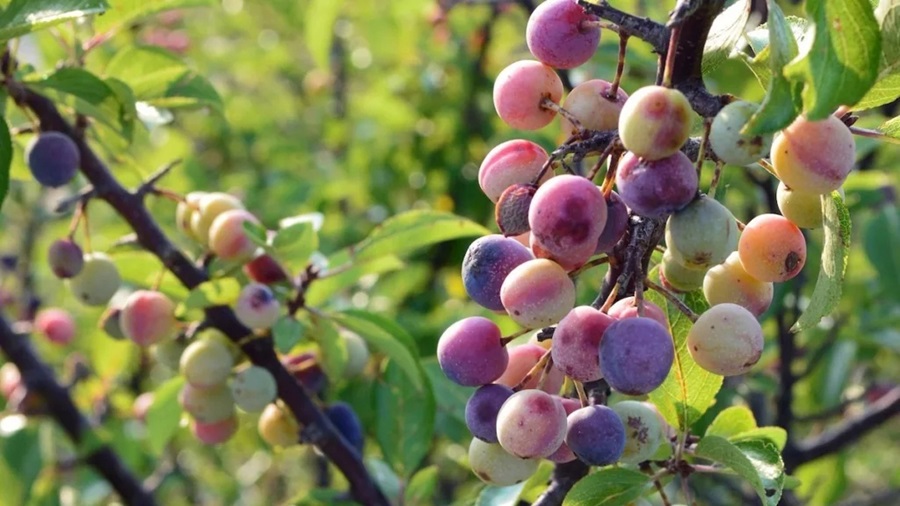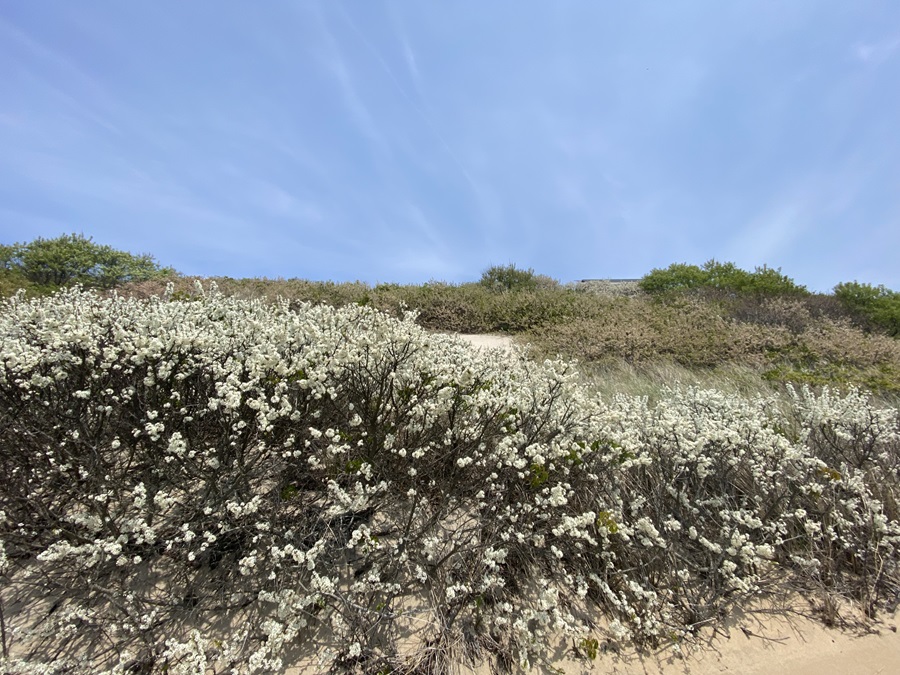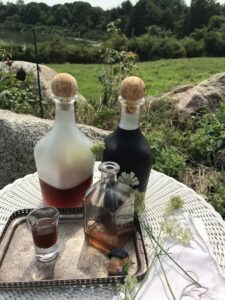Of all the delights that can be made with beach plums — the jam and jelly, sauces, cakes, and tea — for me nothing matches the pure pleasure of beach plum brandy. First, it’s easy to prepare: no pitting of the fruit is necessary. Then, too, this is an especially long-lasting way to capture and savor the changing season.
By the end of August and early September when the plums ripen, the light has turned softer, and the hunting and picking of beach plums etches memories of a fleeting moment. You’ll spend only a few minutes preparing the brandy, but that’s followed by the pleasure of awaiting its development, which requires sampling the results over the next months as the fruit releases its distinctive flavor and aroma and the color deepens to dusky red. It’s ready to serve around the time of winter solstice — a gift of late summer to the new year.

Our neighbor John, a dear friend and a Cape Cod summer resident since the end of World War II, introduced Hugo and me to its pleasures one late night by offhandedly asking if we’d like to sample his homemade hooch. John offered several vintages, and we tasted all of them. It’s easy enough to make, he told us, and we understood that night that a prized custom was being unveiled. Though we did not yet know all that we didn’t know.
A consummate professional in his careers as a classical composer and an attorney, John isn’t one to overcomplicate kitchen tasks. Here’s how he taught us: “Just put the beach plums in a jar with some sugar and a bottle of vodka, stir it up, and it will be ready to drink by Christmas Day.”
“And where do you find the beach plums?” I asked. Pouring refills from yet another vintage, John said, “Oh, we just go out in the kayaks.”
Wild beach plum spirits are variously referred to as a brandy, cordial, or liqueur, and looking into matters I found that you can pretty much call it what you like. The term brandy comes from the Dutch brandewijn, which means burnt wine, because brandy is heated to distill the alcohol in wine or fermented fruit. Both the terms cordial, from the Latin cor for heart, and liqueur refer to spirits and sugar infused with fruit, flowers, or herbs. So, take your pick, depending on the base spirit you choose to begin with. I like the rhythm and alliteration of beach plum brandy as well as the rich flavor brandy imparts. John makes his exclusively with vodka and calls his version Cape Cod sunshine.

As for the wild native beach plum bushes that once abounded along the Atlantic coast from Canada to northern Virginia, they are now far less common and are even endangered in some states, owing to the vast development of shoreline areas and barrier islands. Thus, many people go out to hunt for beach plum bushes in late spring when they are covered with masses of creamy white blossoms and are much easier to spot. Making a note of their location, one can easily return for harvest in late summer. Others cultivate their own bushes.
Well known and appreciated by Native Americans, prunus maritima drew the attention of early European explorers as well as the first colonists in Massachusetts. The fruit is vitamin- and mineral-rich and has a piquant and delicate “I-must-have-more” flavor. The plant, which thrives in sandy soil, is also excellent for conservation purposes including dune stabilization and erosion control.
But all beach plums — stone fruits generally the size of cherries — are not equal; they vary in color when ripe from reds to blues, purples, and almost black, and they vary in flavor. The American Agriculturist reported back in 1872 that some specimens are “quite pleasant to the taste, and others harsh and acerb.” This remains true, and some cultivated varieties may have little if any flavor. The plant is also finicky and gives unpredictable yields. If it’s a bountiful harvest, you may find a gift basket of beach plums on your doorstep, along with the zucchini. Other years — and this seems to be one of those — no one will say a word about where they obtained their supply.

My first casual effort at making beach plum brandy was not a great success. “Undrinkable,” Hugo said. So, I experimented with proportions and technique to come up with this recipe. The quality of the plums you begin with and lightly mashing them make a real difference in flavor, as does the slow infusion of the fruit with spirits. Might you uncork it for Thanksgiving? Sure, but the longer the infusion, the more rewarding the result. You can start with brandy, vodka, or cognac, though purists insist that organic vodka, if available, gives the truest beach plum flavor.
BEACH PLUM BRANDY
Makes one bottle, about a quart
4 cups beach plums, washed well
2 cups sugar
1 bottle brandy, vodka (preferably organic), or cognac
A half-gallon jar, for the fermenting
- In a bowl, lightly mash the plums with the sugar. For this purpose, a potato masher or slotted spoon works well. Transfer the plums to a large glass jar with a tight-fitting lid and pour the spirits over the sugared plums.
- Tighten the lid, give the jar a shake, and set it in a cool, dark cupboard. Every few weeks, stir the brandy, being sure to retighten the lid each time to prevent evaporation.
- In December, with a fine-mesh strainer or several layers of cheesecloth, strain the brandy into a clean bottle or jar; it should just about fill a standard liquor bottle, about 25 oz. Or divide it among smaller bottles for gift-giving.



